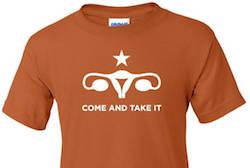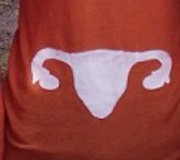Longhorns and Ovaries

Five days before a significant Texas, and Austin, Election Day, I’m stepping back to consider the visual rhetoric employed during Wendy Davis’s famous filibuster and the subsequent protests for women’s reproductive rights at the Texas capitol. I’m particularly interested in the claiming of UT’s particular shade of burnt orange in support of Davis and the revision of the longhorn symbol into a uterus and ovaries.
At the first protest for women’s reproductive rights at the Texas capitol that I attended last spring I remember being confused by the prevalent burnt orange clothing, which I did not initially assume was in support of women, as I associate this color with Texas football culture, not often a feminist space. Was this a misplaced pep rally? It turns out that the claiming of this color and the creative t-shirts it inspired was a wise decision that allowed UT and Texas pride to share a visual space with women’s health and reproductive rights activism.
UT student organizations often appropriate the burnt orange color and/or the longhorn to make their particular political statement, implying that the longhorn, and UT, can stand for many (conflicting) causes. What is the impact of claiming this particular shared shape and/or color? Is it conformist or confrontational? I like to think these images can allow for an activist claiming of school pride, and perhaps indicate a refusal to rally around an undefined longhorn.

Supporters of Wendy Davis’s filibuster used email and social media to encourage all attendees to wear burnt orange. Although it could be argued that this color normalized the visual appearance of the protest, it’s also powerful for an issue as controversial as abortion in Texas to successfully claim UT’s color. It was pretty exciting to see the sea of orange at the capitol all night long in support of the filibuster. (And it was frustrating that many news reports at the time misleadingly suggested that the building was filled with an equal amount of anti and pro-choice activists, when in reality the overwhelming majority of attendees were there in support of Davis).

image credit: occupy
Returning to the most striking claiming of the longhorn I’ve seen, what does it mean to turn an aggressive-looking kind of cattle into female reproductive organs? The above shirt is the official version of the symbol, distributed by Austin printshop Bumperactive and designed by activists Cole Latimer and Carrie Collier-Brown. The horns of the original cow are already in a useful position to serve as ovaries. On the homemade version of the t-shirt (see below) even less tweaking is done to get the image across. In fact on either shirt, there’s not much necessary change to make the longhorn head into a uterus shape. The similarity of the original longhorn and the one that stands for reproductive rights is what gives this image particular power, as it’s jarring and results in lots of double takes. It’s daring and productive to conflate an image most associated with football culture with progressive feminist causes. I appreciate that unlike the hyper-feminized imagery of the breast cancer movement, this image is aggressive yet unquestionably female. By embodying (in more than one way) the longhorn image that most often represents UT pride and football, feminist activists counter patriarchal power structures (sports leadership included), refuse the passivity associated with female sex organs in mainstream misogynist culture, and claim ownership over female reproductive parts and reproductive choices.

I’m not as into the slogan of the official shirts, although its threatening nature has that refreshing aggressive quality, daring politicians to police women’s bodies. The slogan’s most famous origin is on an early Texan flag, along with a cannon and star, made during the conflict often referred to as the War for Texas Independence or the Texas Revolution. The star/slogan combo has become a rallying symbol for the Texas gun rights movement as well.

image credit: Iris Dimmick, Rivard Report
Many other creative visual elements were employed in support of the filibuster. Women taped their mouths shut, visually representing the traditional silencing in the capitol of those supporting women’s rights. Clothing hangers were also present, representing the long history of pro-choice movement and the unsafe alternatives to accessible and legal abortion clinics. Throughout the filibuster, there seemed to be a fear among capitol officials and conservative politicians of disruptive and bodily visual representation. An unfounded rumor that pro-choice attendees were going to throw feminine products or jars of urine and feces onto the floor prompted security to confiscate all tampons and pads from any woman who wished to enter the capitol—this act was also known as “Tampongate.” Although nothing was thrown, disruption was used as a successful intervention when Dewhurst tried to unlawfully declare the filibuster failed just minutes before it was to end: the galley, and then the rest of the capitol, erupted in cries and screams that paused the proceedings.
Clearly, mobilizing a visual representation of women’s reproductive organs is a powerful political statement, especially when it involves the Texas longhorn. Though the fact that an image of a uterus and ovaries is considered shocking or offensive is certainly ironic given the policing and sexualization of women’s bodies in mainstream culture. The filibuster was of course a success that night, and an important rallying point for women’s rights in Texas, but celebrations could only last so long. Another special session was called to get the law passed, resulting in the closure of 40 clinics across Texas. But just recently, on October 15th, the Supreme Court placed a hold on the implementation of the law.



Add new comment